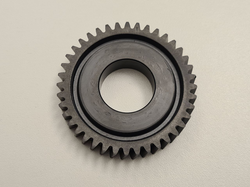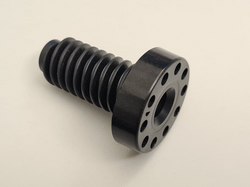Research Topic
| Short Title | LeKka |
| Start of Project | Q1/2021 |
| Funding | BMWK 03LB5002 Federal Ministry for Economic Affairs and Climate Action, BMWK |
| Project Partner | Horst Scholz GmbH & Co KG |
| Contact | Dr.-Ing. J. Pellkofer |
Project Description
Electric drives that are as compact as possible are in demand for a wide range of applications. In addition to use as positioning drives in medical technology or robotics, such drives are also increasingly being applied in means of transport such as electric bicycles [Bos22] or electric scooters.
In order to make such applications resource-efficient, the material needed must be kept as low as possible. Therefore, lightweight design concepts are imperative. The coupling of electric motor and gearbox creates a high potential for weight and cost savings, as this usually allows a significantly smaller motor to be installed than with a direct-drive electric motor. Crossed helical, worm and bevel gearboxes offer many advantages for such applications due to the high transmission ratio possible in a single stage. Crossed helical and bevel gear units also offer a freely selectable axle angle. With these features, space-saving and resource-efficient drives can be developed. In addition, gears made of plastic can be operated without lubrication within suitable materials and operating conditions and also offer great potential for weight and resource savings, low-vibration and low-noise drive acoustics, and cost-effective manufacturing.
At the present time, polymer gears with crossed axles have only been studied to a limited extent scientifically [Bar00, Pec11, Was05] and there are only isolated, partly limited approaches for load carrying capacity calculation and testing [VDI14]. At the same time, plastic gears allow a very free geometry design, which results in a high optimization potential for the efficiency and the load carrying capacity and thus for the power density. In addition, the selection and development of suitable materials and lubricants offers further opportunities to improve the properties of these gears. Consequently, there is a great potential for optimizing weight and efficiency of plastic gears, which are often produced in very large quantities. The basis for such optimizations is a method for reproducible and comparable testing and design, but this is not yet available in this form. For plastic gears with crossing axles, a flexible test rig concept is to be developed and implemented within the scope of this project. This allows to investigate different types and sizes of gears. On the basis of experimental investigations, a standardized test method for plastic gears with crossed axles is to be developed.
Literature
[Bar00] Barton, P.: Tragfähigkeit von Schraubrad- und Schneckengetrieben der Werkstoffpaarung Stahl/Kunststoff, Dissertation, Ruhr Universität Bochum (2000).
[Bos22] Bosch eBike Systems: Active Line: der harmonische Bosch Motor für Elektrofahrräder. URL: https://www.bosch-ebike.com/de/produkte/active-line. Abrufdatum 21.04.2022.
[Pec11] Pech, M.: Tragfähigkeit und Zahnverformung von Schraubradgetrieben der Werkstoffpaarung Stahl/Kunststoff, Dissertation, Ruhr Universität Bochum (2011).
[VDI14] VDI 2736-3:2014-05: Thermoplastische Zahnräder - Schraubradgetriebe – Paarung Zylinderschnecke Schrägstirnrad - Tragfähigkeitsberechnung (2014).
[Was05] Wassermann, J.: Einflussgrößen auf die Tragfähigkeit von Schraubradgetrieben der Werkstoffpaarung Stahl / Kunststoff, Dissertation, Ruhr Universität Bochum (2005).

